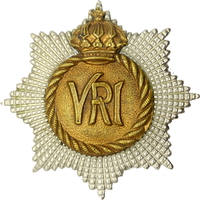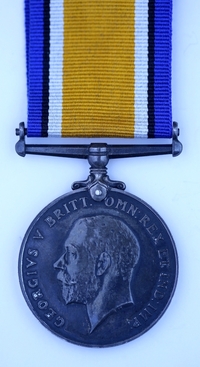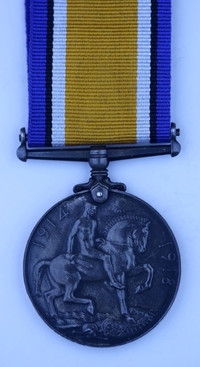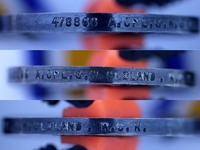
478866 Pte George William Cleland
The Royal Canadian Regiment
By: Capt (ret'd) Michael M. O'Leary, CD, The RCR
George William Cleland was born in Toronto, Ont., on 1 Dec 1897. Cleland's family, led by parents Thomas M. (42) and Agnes (30), can be found in the 1901 Canadian Census for Toronto. Sharing the household are Thomas' parents, George ("Sr.", 67) and Elizabeth (60).
George W. also appears in the 1911 Census. At the age of 13, he was living with his maternal grandparents James (66) and Catharine (64) Piggott in Midland, Ont. George's parents, with younger siblings Ruth (9) and Russell (7), were living in Vancouver, B.C.
Cleland enlisted in the Permanent Force with The Royal Canadian Regiment at Toronto, Ont., on 14 May 1915. He was given a regimental number, 20336, which indicates a wartime P.F. enlistment. One week after enlisting, Cleland was transferred to the Regimental Depot at Halifax, N.S., and arrived at his new station on 21 May 1915.
When Cleland arrived in Halifax, The RCR had been serving in Bermuda on garrison duty since the previous fall. On 11 Sep 1914, The Royal Canadian Regiment sailed for Bermuda where they relieved the 2nd Battalion, Lincolnshire Regiment, which sailed immediately for England. On 12 Aug 1915, The RCR was relieved in turn by the arrival of the 38th Overseas Battalion from Canada. The RCR returned to Halifax for a stay of only a week. On 26 Aug 1915, The RCR sailed from Halifax aboard the S.S. Caledonian, the same ship that had brought them home from Bermuda. Disembarked at Plymouth, England, on 6 Sep 1915, the Regiment went to Shorncliffe for training. On 1 Nov 1915, The RCR crossed the English Channel, entering the theatre of war at Boulogne, France.
Cleland remained in Halifax when The RCR sailed for Europe. He must have been found useful and eventually was employed as an Orderly Room Clerk, a role which kept him from joining the various overseas drafts assembled and despatched by the Regimental Depot.
On 5 Feb 1918, Cleland attested at Halifax for service in the Canadian Expeditionary Force (C.E.F.). Although this changed the terms of his service, he remained on duty with the Regimental Base Depot. An 18-year-old clerk, Cleland was described in his service record as 5 feet 8 1/4 inches tall, weighing 130 pounds, with a 35-inch chest, a dark complexion, brown eyes, and black hair. His religious denomination was Methodist. Cleland identified his mother, Mrs. Thomas Cleland, 1837 William St., Vancouver, B.C., as his next of kin. On attesting for C.E.F. service, Cleland was given the service number 478866.
By early 1918, Cleland held the rank of Sergeant at the Regimental Depot in Halifax. In May, 1918, he was reported illegally absent and the Depot, following the usual protocols, soon thereafter struck him off strength as a deserter effective 17 May 1918, the first day of his absence.
Cleland may have left the Regimental Depot, but it was not his intention to avoid military service. Boarding a troop ship docked in Halifax Harbour, Cleland sailed from Halifax aboard the S.S. Valacia. A Cunard liner, the Valacia was crossing the Atlantic with 1020 troops for the C.E.F. This was the Valacia's first voyage from Halifax carrying C.E.F. troops, and it would make one more visit to the port city and transport another 185 troops two months later. Once the ship was at sea, Cleland knew it would not be turned around to return him to Halifax. As an illegal absentee from The RCR, he surrendered himself as a stowaway to the shipboard military authorities.
The Valacia disembarked its load of troops at Liverpool on 27 May 1918 and the following day Cleland was taken on the strength of the 17th Reserve Battalion at Bramshott in the rank of Private. Other than the change of rank, there does not appear to be any record of administrative or disciplinary actions taken because of his desertion.
It is likely that after years of being retained in Canada, Cleland had taken the only steps he could think of to ensure he joined the Regiment at the front before the war ended. His record of service sheet which begins with his arrival in England notes his qualifications as "Clerk" and "(Orderly Room)." That skillset and experience may explain why he was retained in Halifax at the Regimental Depot through much of the war.
As for all new arrivals at the time, Cleland spent his first month in England in quarantine at a segregation camp. Soldiers arriving at Bramshott spent that time in the Segregation Camp at Frensham Pond.
On a new attestation paper completed at Bramshott and back-dated to 16 May 1918 (which at least granted him the perception of unbroken service), Cleland's prior service was noted as "Perm. Force R.C.R., 3 years, 2 days." Still listing his mother as next of kin, her address was updated to 56 26th Avenue South, Vancouver, B.C.
After rejoining the 17th Res. Bn. on 25 Jun 1918, Cleland was promoted to Acting Lance Corporal (with pay) three days later. He was also examined by the Medical Officer of the 17th Res. Bn. on 26 Jun 1918 to confirm his fitness for service. The positive effects of regular rations can be seen in Cleland's new Medical History Sheet. It is noted that he had grown to 5 feet 10 inches in height and gained weight, to 145 pounds.
Cleland kept his acting Lance Corporal's rank stripe for less than a month. On 21 Aug 1918 he reverted in rank to Private in order to proceed overseas to join The RCR in France. This reversion in rank was normal for any non-commissioned officers who did not have trench experience. Units at the front needed soldiers and could fill their own N.C.O. vacancies from within by promoting experienced men. Capable soldiers who reverted in rank often regained their rank quickly after they had adjusted to the routines and responsibilities of trench warfare.
Arriving in France as a reinforcement for The RCR, Cleland was taken on the strength of the Regiment from 22 Aug 1918. After crossing then Channel, he joined the Canadian Infantry Base Depot (C.I.B.D.) to await orders to join the Regiment. Four days later, on 26 Aug 1918, Cleland was transferred to the Canadian Corps Reinforcement Camp (C.C.R.C.). Two days after that he joined The RCR in the field as the Regiment moved into Billets at Arras.
Cleland's first month with the Regiment was a three-week cycle of Corps, Divisional, and Brigade Reserve. This was followed by a move from the Arras area to Bernville on 19 Sep 1918 and then onward to Queant on 26 Sep 1918. Cleland's baptism of fire would come on the morning of 28 Sep 1918, with the attack on the Marcoing Line.
The activities of The RCR during the final days of September, 1918, are summarized in the unit's "Battle Bar Document" (prepared after the war by the Militia Department in anticipation of the possibility of clasps for the British War Medal):
- 28 Sep 1918
- 5.30 a.m. – Advanced to the attack on the MARCOING LINE and after severe fighting the line was established in vicinity of ARRAS-CAMBRAI ROAD in F.6.a. & c. Sheet 57.C. NE.
- 29 Sep 1918 – Bn in Reserve in F.6.a. & c.
- 30 Sep 1918
- Assembled at 5.30 a.m. in S.19.central. Sheet 51.A.
- 6 a.m. – Bn attacked positions NORTH of TILLOY. heavy resistance was met with and Bn compelled to dig in in S.20.b. and S.21.a. Sheet 51.A. vicinity of TILLOY-BRECOURT ROAD.
- 1 Oct 1918 – 9th Bde passed through the Bn's positions and Bn moved back to QUARRY WOOD.
The casualties suffered by the Regiment on the first day of the battle resulted in a reorganization to three companies before continuing the operation on 30 Sep 1918. The War Diary listed the following casualties in those closing days of September, 1918: Officers: Killed in Action, 3; Died of Wounds, 1; Wounded, 16. Other Ranks Killed in Action, 51; Died of Wounds, 1; Wounded in Action, 185; Missing, 53; Wounded at Duty, 3. A narrative annex attached to the War Diary includes an indication of the Regiment's successes as well: "Estimated Machine Guns captured amounted to 54. Prisoners seen returning 130, captured guns and anti-tank guns 5. Casualties inflicted on the enemy were approximately 700."
Cleland survived his first major action at the front. His introduction to the style of warfare that would see the Canadian Corps through the final months of the war set the tone for following operations. Movement, assault, and the capture of successive German lines as the Regiment and other units of the Canadian Corps drove the Germans backwards. Through it all Cleland would survive with not even a reported minor wound.
After the Armistice, The RCR continued to serve in Europe as the process to return Canada's soldiers to their homes proceeded at a pace dictated by available transportation resources. For The RCR, that homeward movement would begin in February, 1919. Cleland proceeded to England with the Regiment on 6 Feb 1919, the first stage of the return trip to Canada.
On 1 Mar 1919, Cleland was struck off the strength of the Overseas Military Forces of Canada (O.M.F.C.) on sailing from Liverpool, Eng. Disembarked at Halifax on 9 Mar 1919, Cleland was taken on the strength of No. 6 District Depot, Halifax, and posted to Disposal Station "B" for discharge.
L/Cpl George Cleland was discharged from the C.E.F. on demobilization at Halifax, N.S., on 15 Mar 1919. His discharge certificate summarized his operational service as "in The RCR in France." In a space for recording Marks or Scars, to assist with ensuring a man presenting his Discharge Certificate for identification could be matched to it by distinctive marks, his tattoos were described. These were "heart pierced and anchor, left forearm; American eagle and skull & crossed bones, right forearm." Cleland's certificate also confirmed the issue of a Class "A" War Service Badge, numbered 233167.
The day after his discharge from the C.E.F., 16 Mar 1919, Cleland re-enlisted in the Permanent Force at Halifax, N.S., at the age of 21. He was assigned a new post-war regimental number, 12037.
On discharge, Cleland was eligible to receive a War Service Gratuity of $420. This was paid to him in installments between March and August, 1919.
Cleland only served four months of his post-war Permanent Force engagement. He was struck off strength on 14 Jul 1919 and again declared a deserter. A Court of Inquiry was conducted on 5 Aug 1919.
At the time of the 1921 Canadian Census, George (23) was living in Vancouver with his family. The household included his parents, Thomas (60) and Agnes (49), and both sister Ruth (19) and brother Russell (17).
For his service in the C.E.F., Cleland was entitled to receive the British War Medal and the Victory Medal. These were despatched to him at 3100 Ontario St., Vancouver, B.C., on 24 Apr 1923.
On 6 Feb 1924, at the age of 26, George Cleland married 19-year-old music teacher Mildred Helen Eppinger at Mt. Pleasant Presbyterian Church, Vancouver. On their registration of marriage, George's occupation was recorded as "Ticket Clerk, Canadian Pacific Railway." The witnesses on record for the ceremony were George's brother and sister, Russell and Ruth.
George William Cleland died on 23 Dec 1979 at Vancouver, B.C. His death came the day after he took a fall in the street. The cause of his death was recorded as respiratory failure complicated by lung cancer. Mildred would survive her husband another four years before dying of heart disease. Both Ernest and Mildred were cremated and no place of burial is recorded on their death registrations.
Pro Patria
Visit a randomly selected page in The O'Leary Collection (or reload for another choice):
- The O'Leary Collection; Medals of The Royal Canadian Regiment.
- Researching Canadian Soldiers of the First World War
- Researching The Royal Canadian Regiment
- The RCR in the First World War
- Badges of The RCR
- The Senior Subaltern
- The Minute Book (blog)
- Rogue Papers
- Tactical Primers
- The Regimental Library
- Battle Honours
- Perpetuation of the CEF
- A Miscellany
- Quotes
- The Frontenac Times
- Site Map
QUICK LINKS
The O'Leary Collection—Medals of The Royal Canadian Regiment
Newest additions:
![]()
![]() SB-12725 Private Henry "Hank" Ard
SB-12725 Private Henry "Hank" Ard ![]()
WIA at Hill 187, Died of Wounds in Japan
![]()
![]() 2355331 Lance Corporal Albert Lorking
2355331 Lance Corporal Albert Lorking
Wounded in action, later a War Amps representative.
![]()
![]() 4334 / 477996 Pte Isaac Hamilton Wilcox
4334 / 477996 Pte Isaac Hamilton Wilcox
Permanent Force, South Africa, and C.E.F.
![]()
![]() 477019 Private Harold Ashcroft
477019 Private Harold Ashcroft
Transferred to the Tunnelers.
![]()
![]() 734231 Private Clark D. Thompson
734231 Private Clark D. Thompson ![]()
The older Thompson brother, killed in action.
![]()
![]() 733849 Private Norman Parker Thompson
733849 Private Norman Parker Thompson
The younger Thompson brother; post-war service in the Special Guard.
![]()
![]()
![]() A305 / 400305 Private Andrew Walker
A305 / 400305 Private Andrew Walker ![]()
"Previously reported Wounded, now Killed in Action."
![]()
![]() 823298 Pte Thomas Patrick Steele, M.M.
823298 Pte Thomas Patrick Steele, M.M. ![]()
… for gallant conduct in the field …
![]()
![]() P13066 Sergeant Harold Thompson
P13066 Sergeant Harold Thompson
Instrumental Soloist for over 20 years of Canadian Army service.
![]()
![]() 9609 / 477728 Private Albert Edward Piper
9609 / 477728 Private Albert Edward Piper
"Arrived from England as a STOWAWAY …"




